Four Great Scenic Coastal Drives in Bali
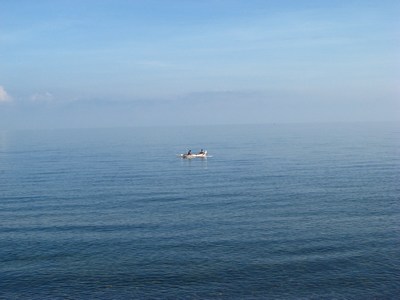 An island covering an area of 5, 561 sq kilometres and totally surrounded by oceans it is only natural that a lot of the coastline and the coastal roads can be spectacular not only to drive along, but with the added bonus of outstanding panoramic views.
An island covering an area of 5, 561 sq kilometres and totally surrounded by oceans it is only natural that a lot of the coastline and the coastal roads can be spectacular not only to drive along, but with the added bonus of outstanding panoramic views.
Fortunately, with the advent of tourism in Bali a majority of the coastal roads have been upgraded to ensure safer driving, and now, with the completion of the Prof. Dr Ida Bagus Mantra Bypass in the south of the island, travellers can now circumnavigate the island by road; but not in one day!
The one delight about travelling along the majority of the coastal sections is that you get to stop at small villages less visited by tourists and get off the beaten track to visit a waterfall or maybe a small arts centre. Indeed, a lot of these coastal roads are free of tourist buses, however, you do have to contend with the annoying trucks going back and forth around the island. A small price to pay for the wonders you will discover.
The North-East Coast Road:
 The whole section of the east coastal road is particularly beautiful and affords some delightful views across the straits dividing Lombok from Bali. It’s quite easy getting there and just take any road north to Kintamani. Once there, continue north along the mountain road to the connecting road onwards to Singaraja. Not far and you will see a turn-off to the right at a village called Dusa. This takes you down to the coastal road. At the coast turn left. This road will take you along the north-east coastal road to Singaraja. Besides the stunning ocean views you will pass through a lot of small villages; a lot seemingly unaffected by the mass tourism n the island. Do stop at a couple of these places and in particular Pacung. There is a good traditional market there. Continuing north you will come to a shallow bend in the road at Cape Sanih. Here, the water is crystal clear and it’s easy to get down to the shoreline, watch the beach fishermen or if your fancy takes you and you have your snorkelling gear, go explore the ocean. Be careful though because the currents are relatively strong around there.
The whole section of the east coastal road is particularly beautiful and affords some delightful views across the straits dividing Lombok from Bali. It’s quite easy getting there and just take any road north to Kintamani. Once there, continue north along the mountain road to the connecting road onwards to Singaraja. Not far and you will see a turn-off to the right at a village called Dusa. This takes you down to the coastal road. At the coast turn left. This road will take you along the north-east coastal road to Singaraja. Besides the stunning ocean views you will pass through a lot of small villages; a lot seemingly unaffected by the mass tourism n the island. Do stop at a couple of these places and in particular Pacung. There is a good traditional market there. Continuing north you will come to a shallow bend in the road at Cape Sanih. Here, the water is crystal clear and it’s easy to get down to the shoreline, watch the beach fishermen or if your fancy takes you and you have your snorkelling gear, go explore the ocean. Be careful though because the currents are relatively strong around there.
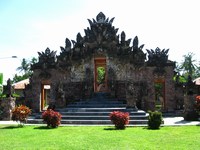 Roughly a few kilometres from Cape Sanih you will arrive at a lovely place called Yeh Sanih. Although it now has a resort built around it, the cool water springs that are believed to originate from Danau Bratan are fabulous on a hot day! The large town of Kubutambahan is one of those places along this stretch of road to check out even if it’s only to visit one of the many temples that are unique to this area. My recommendation would be Pura Meduwe, a temple dedicated to Batara Meduwe Karang. Spectacular grounds and beautiful terrace carvings are awesome. And, if you really want to see an unusual temple then not far from Kubutambahan is Pura Beji, a temple dedicated to Dewi Sri. I was amazed when I last visited this temple to find some carvings of Dutch musicians! Carrying on along the coastal road you will finally arrive at the original capital of Bali, Singaraja. From there it is a matter of taking the road south passing Danau Bratan and onto Kuta.
Roughly a few kilometres from Cape Sanih you will arrive at a lovely place called Yeh Sanih. Although it now has a resort built around it, the cool water springs that are believed to originate from Danau Bratan are fabulous on a hot day! The large town of Kubutambahan is one of those places along this stretch of road to check out even if it’s only to visit one of the many temples that are unique to this area. My recommendation would be Pura Meduwe, a temple dedicated to Batara Meduwe Karang. Spectacular grounds and beautiful terrace carvings are awesome. And, if you really want to see an unusual temple then not far from Kubutambahan is Pura Beji, a temple dedicated to Dewi Sri. I was amazed when I last visited this temple to find some carvings of Dutch musicians! Carrying on along the coastal road you will finally arrive at the original capital of Bali, Singaraja. From there it is a matter of taking the road south passing Danau Bratan and onto Kuta.
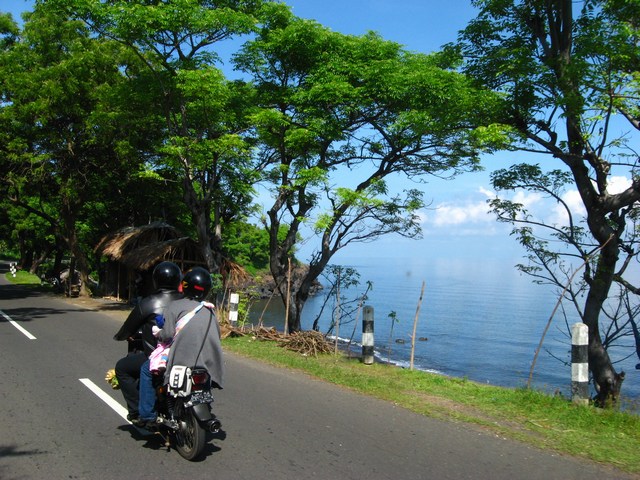
The East-South Coast Road:
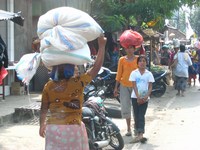 Getting to this section of road is the same as in the direction north for the north-east coast road but after getting down to the coast road T-junction at Bondalem, turn tight heading south. Area around Bondalem and the other smaller villages along this road will capture your attention mainly because it is virtually untouched by tourism and close to the old Bali. Basically the locals rely on fishing and along the stretches of beach you will pass nets can be seen drying out. The road is bituminized but narrow and potholed! The mountains shadow your journey along this section of the road and as you pass through the village of Tejakula you will see a small sign on the road at Les directing you to Yeh Mempeh; a waterfall purportedly to be the highest on Bali. It is a fair hike up to the waterfall but well worth a visit and especially during the rainy season. Further along this stretch of narrow road there are two capes worthy of a stop – Cape Ngis and Cape Tekurenan; the latter being of interest to divers for its shallow reefs. Both are picturesque.
Getting to this section of road is the same as in the direction north for the north-east coast road but after getting down to the coast road T-junction at Bondalem, turn tight heading south. Area around Bondalem and the other smaller villages along this road will capture your attention mainly because it is virtually untouched by tourism and close to the old Bali. Basically the locals rely on fishing and along the stretches of beach you will pass nets can be seen drying out. The road is bituminized but narrow and potholed! The mountains shadow your journey along this section of the road and as you pass through the village of Tejakula you will see a small sign on the road at Les directing you to Yeh Mempeh; a waterfall purportedly to be the highest on Bali. It is a fair hike up to the waterfall but well worth a visit and especially during the rainy season. Further along this stretch of narrow road there are two capes worthy of a stop – Cape Ngis and Cape Tekurenan; the latter being of interest to divers for its shallow reefs. Both are picturesque.
 Around this area the flora changes and is seemingly fertile and greener with trees lining the road. Tulamben is probably the most popular site for dive tourists along the south-east coast road. Famous for the sunken wreck of the USS Liberty, Tulamben doesn’t offer much to anyone not interested in diving or snorkelling, but, it does have some delightful beaches graced with fishing boats and friendly locals. Lining the street are dive shops and a few warungs. The whole ocean area around Tulamben is actually a Marine Reserve and thus protected and it’s worth a stop just to check out the beaches! From Tulamben the coastal road tends to leave the coast and goes slightly inland until you arrive at a place called Culik where you turn left and return to the coast at Amed; another serene area, peaceful and a delightful place to stay for a few days. With Gunung Seraya rising high on your right-hand side, this is the section of the road that gets very narrow, hairy and winding and for those with a pacemaker don’t even venture along here! When you have your breath back along this dry stretch of, er, road, you will eventually arrive at Ujung and here is where you will find the floating palace; photographically beautiful. From here it is a simple mater of taking the south road back to Kuta.
Around this area the flora changes and is seemingly fertile and greener with trees lining the road. Tulamben is probably the most popular site for dive tourists along the south-east coast road. Famous for the sunken wreck of the USS Liberty, Tulamben doesn’t offer much to anyone not interested in diving or snorkelling, but, it does have some delightful beaches graced with fishing boats and friendly locals. Lining the street are dive shops and a few warungs. The whole ocean area around Tulamben is actually a Marine Reserve and thus protected and it’s worth a stop just to check out the beaches! From Tulamben the coastal road tends to leave the coast and goes slightly inland until you arrive at a place called Culik where you turn left and return to the coast at Amed; another serene area, peaceful and a delightful place to stay for a few days. With Gunung Seraya rising high on your right-hand side, this is the section of the road that gets very narrow, hairy and winding and for those with a pacemaker don’t even venture along here! When you have your breath back along this dry stretch of, er, road, you will eventually arrive at Ujung and here is where you will find the floating palace; photographically beautiful. From here it is a simple mater of taking the south road back to Kuta.
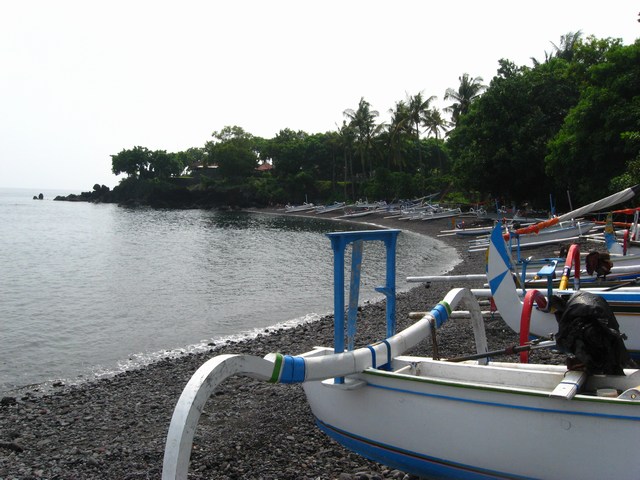
The Southern Coastal Road:
 Commonly known as the Prof. Dr Ida Bagus Mantra Bypass, this stretch of road will take you from the tourist areas around Kuta direct to the eastern part of Bali. As a highway of sorts, the road skirts the southern coastline initially passing mangrove swamps and further on shrimp ponds; all of which are interesting in their own right. There are a few temples along this first section worthy of a visit; Pura Mesceti and Pura Segera. However, it’s not until you get past the turnoff at Lebih do things get interesting. Although Pura Batu Klotok is worth a look if not only for the sea vistas, it is at the salt producing town of Kusamba where you will find the best photographic opportunities. A farming, fishing and salt producing village, Kusamba is also the place where you catch boats to the islands of Nusa Penida and Nusa Lembongan. About three kilometres further along the road you will come to the sacred temple Pura Goa Lawah, known to tourist as the Bat Cave. Founded in 1007, Pura Goa Lawah is one of the nine directional temples on Bali. The cave, located in the rear of the temple is full of bats and they are worshipped, sacred and protected. There are nice ocean views from this temple and if you can be there during a temple ceremony it is a sight not to be missed and definitely not disappointing.
Commonly known as the Prof. Dr Ida Bagus Mantra Bypass, this stretch of road will take you from the tourist areas around Kuta direct to the eastern part of Bali. As a highway of sorts, the road skirts the southern coastline initially passing mangrove swamps and further on shrimp ponds; all of which are interesting in their own right. There are a few temples along this first section worthy of a visit; Pura Mesceti and Pura Segera. However, it’s not until you get past the turnoff at Lebih do things get interesting. Although Pura Batu Klotok is worth a look if not only for the sea vistas, it is at the salt producing town of Kusamba where you will find the best photographic opportunities. A farming, fishing and salt producing village, Kusamba is also the place where you catch boats to the islands of Nusa Penida and Nusa Lembongan. About three kilometres further along the road you will come to the sacred temple Pura Goa Lawah, known to tourist as the Bat Cave. Founded in 1007, Pura Goa Lawah is one of the nine directional temples on Bali. The cave, located in the rear of the temple is full of bats and they are worshipped, sacred and protected. There are nice ocean views from this temple and if you can be there during a temple ceremony it is a sight not to be missed and definitely not disappointing.
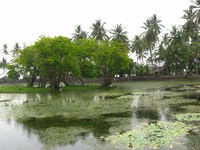 From Pura Goa Lawah the road turns inland for a section but just as quickly returns to the coast not far from the tourist area of Candi Dasa. Unfortunately, following the Bali bombings, tourism in Candi Dasa suffered dramatically but, it is pleasing to see that the area is on the destination radar again for travellers. Like a lot of areas in the east coast of Bali, Candi Dasa has some fabulous places for divers and snorkellers namely Gili Kambang, Gili Biaha and Gili Mimpang. It’s not only the ocean activities that are appealing. The whole area exudes peace and quiet coupled with a laid-back atmosphere. There are excellent hiking opportunities in the hills at the rear of this ancient settlement and is an ideal base for visiting the inner cultural attractions Bali has to offer. These include the Bali Aga village of Tenganan and the stunning panoramic views around the village of Sibetan. From here the vista of Bali’s sacred mountain, Gunung Agung, are breathtakingly awesome. Further along, the coastal road goes inland to Amlapura. Visiting the Tirtagangga Water Palace to the north of this town is not to be missed and, if you travel a little further on north you arrive at a small place called Abang overlooking a valley. Located in the valley is the village of Ngis surrounded by rice paddies. Without a doubt the views over this village and surrounding rice fields are probably the best you will see on the island of Bali.
From Pura Goa Lawah the road turns inland for a section but just as quickly returns to the coast not far from the tourist area of Candi Dasa. Unfortunately, following the Bali bombings, tourism in Candi Dasa suffered dramatically but, it is pleasing to see that the area is on the destination radar again for travellers. Like a lot of areas in the east coast of Bali, Candi Dasa has some fabulous places for divers and snorkellers namely Gili Kambang, Gili Biaha and Gili Mimpang. It’s not only the ocean activities that are appealing. The whole area exudes peace and quiet coupled with a laid-back atmosphere. There are excellent hiking opportunities in the hills at the rear of this ancient settlement and is an ideal base for visiting the inner cultural attractions Bali has to offer. These include the Bali Aga village of Tenganan and the stunning panoramic views around the village of Sibetan. From here the vista of Bali’s sacred mountain, Gunung Agung, are breathtakingly awesome. Further along, the coastal road goes inland to Amlapura. Visiting the Tirtagangga Water Palace to the north of this town is not to be missed and, if you travel a little further on north you arrive at a small place called Abang overlooking a valley. Located in the valley is the village of Ngis surrounded by rice paddies. Without a doubt the views over this village and surrounding rice fields are probably the best you will see on the island of Bali.

The South-West Road:
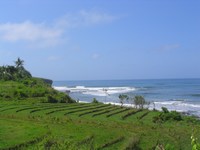 This is a great road taking you through some of the arid areas in the west of Bali but don’t think it’s not picturesque because, it is. Travelling inland north from the Kuta area to the town of Tabanan (famed for its numerous stone statues and sculptures) the road continues in a westerly direction taking you through some hairy switchback stretches but finally at the village of Antosari you then let and head down to the coast arriving at a delightful place called Soka Beach. The last time I was there it took me by surprise just how beautiful it was with paddy fields stretching from the hills right down to the beach. There is a villa estate complex being established there but it will not detract you from the beauty and the wild surf pounding the shoreline. Do take time there to refresh yourself at a small restaurant and take in the awesome vistas. From Soka the road hugs the coast and you will pass the world-class surf breaks of Balian Beach and that at Medewi. Both are worth checking out.
This is a great road taking you through some of the arid areas in the west of Bali but don’t think it’s not picturesque because, it is. Travelling inland north from the Kuta area to the town of Tabanan (famed for its numerous stone statues and sculptures) the road continues in a westerly direction taking you through some hairy switchback stretches but finally at the village of Antosari you then let and head down to the coast arriving at a delightful place called Soka Beach. The last time I was there it took me by surprise just how beautiful it was with paddy fields stretching from the hills right down to the beach. There is a villa estate complex being established there but it will not detract you from the beauty and the wild surf pounding the shoreline. Do take time there to refresh yourself at a small restaurant and take in the awesome vistas. From Soka the road hugs the coast and you will pass the world-class surf breaks of Balian Beach and that at Medewi. Both are worth checking out.
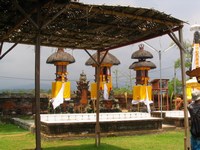 Not far from the small town of Mendoyo you will find Pura Rambut Siwi. It is one of the coastal temples in Bali and is perched on a cliff. The temple was founded in the 16th Century by a Hindu priest from Java named Niratha. He loved the location and after building the temple spent his time spreading the Hindu religion in the Bali. Before he left the temple he gave a lock of his hair and a set of his clothes which are supposedly still at Pura Rambut Siwi stored in the inner courtyard. The temple is now known as ‘the temple for worshipping the hair’. Travelling further west you will come to the town of Negara. It is the main town in west Bali. Here they hold the mecepung or buffalo races in Perancak nearby. Negara has a strong Muslim influence being located close to Java, with a large mosque in the centre of town. Highlights of Negara itself, other than the buffalo races include the bamboo gamelan orchestra which the area is famous for. This is called a gamelan jegog. Travelling further to the western most point of Bali at Gilamanuk where the ferry goes to Java, you will find the area becomes even more arid but the ocean views nonetheless awesome. To the north of this road is the Bali Barat National Park, and indeed well worth a visit, take a hike through the jungles and if your lust for adventure takes then camp out or stay at one of the lodges there.
Not far from the small town of Mendoyo you will find Pura Rambut Siwi. It is one of the coastal temples in Bali and is perched on a cliff. The temple was founded in the 16th Century by a Hindu priest from Java named Niratha. He loved the location and after building the temple spent his time spreading the Hindu religion in the Bali. Before he left the temple he gave a lock of his hair and a set of his clothes which are supposedly still at Pura Rambut Siwi stored in the inner courtyard. The temple is now known as ‘the temple for worshipping the hair’. Travelling further west you will come to the town of Negara. It is the main town in west Bali. Here they hold the mecepung or buffalo races in Perancak nearby. Negara has a strong Muslim influence being located close to Java, with a large mosque in the centre of town. Highlights of Negara itself, other than the buffalo races include the bamboo gamelan orchestra which the area is famous for. This is called a gamelan jegog. Travelling further to the western most point of Bali at Gilamanuk where the ferry goes to Java, you will find the area becomes even more arid but the ocean views nonetheless awesome. To the north of this road is the Bali Barat National Park, and indeed well worth a visit, take a hike through the jungles and if your lust for adventure takes then camp out or stay at one of the lodges there.
